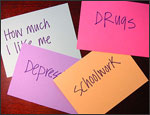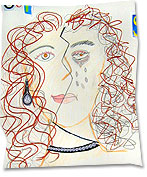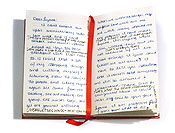All good things which exist
are the fruit of originality.
-John Stuart Mill, 1859
 Many people, in almost all professions, need tools to get their jobs done. Builders use tools to build the homes we live in. A surgeon needs tools to save lives. A potter a wheel to create a vessel. Many people, in almost all professions, need tools to get their jobs done. Builders use tools to build the homes we live in. A surgeon needs tools to save lives. A potter a wheel to create a vessel.
 To some it might be an odd thing to name a psychotherapy practice. Creative Tools for Health and Healing is a name that best describes something Lynne has done over many years in practice for a very special reason. You might think that as an art therapist and play therapist, Lynne would have had plenty of tools from the beginning. After all, you just have to buy them, as most such therapists do. But over the years she found she didn’t have what she needed, despite all the art supplies and puppets and dollhouse families. Part of the reason she is so good at what she does is that she can intuitively know exactly what a patient needs at a given moment and pull it out immediately, spontaneously. Before a child’s distraction takes over, an adolescent's resistance builds, an adult perhaps gets skeptical or frightened. And over the years, a lot of things that she wanted and needed...weren’t in her office because they didn’t exist. To some it might be an odd thing to name a psychotherapy practice. Creative Tools for Health and Healing is a name that best describes something Lynne has done over many years in practice for a very special reason. You might think that as an art therapist and play therapist, Lynne would have had plenty of tools from the beginning. After all, you just have to buy them, as most such therapists do. But over the years she found she didn’t have what she needed, despite all the art supplies and puppets and dollhouse families. Part of the reason she is so good at what she does is that she can intuitively know exactly what a patient needs at a given moment and pull it out immediately, spontaneously. Before a child’s distraction takes over, an adolescent's resistance builds, an adult perhaps gets skeptical or frightened. And over the years, a lot of things that she wanted and needed...weren’t in her office because they didn’t exist.
 So she made them. So she made them. 
 And what she made works brilliantly. And just like with verbal psychotherapy, where the therapist teaches people skills, and lets them practice those skills first in sessions, and then sends them out into the world with them—these are tools that can translate similarly. They are tools that can teach, tools that patients can use for health and healing for the rest of their lives. Some are tools that patients are given sets of to take home with them, during treatment and/or upon termination. And what she made works brilliantly. And just like with verbal psychotherapy, where the therapist teaches people skills, and lets them practice those skills first in sessions, and then sends them out into the world with them—these are tools that can translate similarly. They are tools that can teach, tools that patients can use for health and healing for the rest of their lives. Some are tools that patients are given sets of to take home with them, during treatment and/or upon termination.
 This is a short list of some of the creative tools Lynne has created herself and some explanations as to how a few are used. Some work best for individuals; others are great for groups and families. This is a short list of some of the creative tools Lynne has created herself and some explanations as to how a few are used. Some work best for individuals; others are great for groups and families.
The 'What’s New' Cards™
 LYNNE: “A pack of cards, made in my handwriting, on fun colored paper; one set for younger children, one for teens, and one for adults. Each card has one topic, word or phrase. These might be “my mom”, “sex”, “friends”, or "therapy." About twenty cards are placed face down on the table. The patient picks them up one-by-one. They then have to tell something about them that deals with this topic that I don't already know because they haven’t already told me. LYNNE: “A pack of cards, made in my handwriting, on fun colored paper; one set for younger children, one for teens, and one for adults. Each card has one topic, word or phrase. These might be “my mom”, “sex”, “friends”, or "therapy." About twenty cards are placed face down on the table. The patient picks them up one-by-one. They then have to tell something about them that deals with this topic that I don't already know because they haven’t already told me. 
 “After this is done a few times, it can be difficult for them to tell me more (something new,) but still, as with all of the creative tools, the difficulty is cushioned by some lightness and fun. This keeps them coming back while helping them to stay brave enough to keep pushing through complex material. I’m always saying things like ‘You told me that about your dad already’ or ‘I know that about your boyfriend!’ There is always giggling and of course sometimes tears when we pause to really talk about something new. The benefit for me is that I am always getting new information without the patient being bored. With the traditional verbal therapy approach of the patient sitting on the couch and being and asked “what’s new?” which typically resistant kids and adolescents don’t like (the answer is often “nothing”…with a big shrug and the patient most probably in deep emotional pain.) Patients enjoy the What’s New Cards. We do this every few weeks, (and I always know what's new.” There have been many, many times when these cards have led to a disclosure of high risk behavior, for example, experimentation with drugs, skipping school or unsafe sex. “After this is done a few times, it can be difficult for them to tell me more (something new,) but still, as with all of the creative tools, the difficulty is cushioned by some lightness and fun. This keeps them coming back while helping them to stay brave enough to keep pushing through complex material. I’m always saying things like ‘You told me that about your dad already’ or ‘I know that about your boyfriend!’ There is always giggling and of course sometimes tears when we pause to really talk about something new. The benefit for me is that I am always getting new information without the patient being bored. With the traditional verbal therapy approach of the patient sitting on the couch and being and asked “what’s new?” which typically resistant kids and adolescents don’t like (the answer is often “nothing”…with a big shrug and the patient most probably in deep emotional pain.) Patients enjoy the What’s New Cards. We do this every few weeks, (and I always know what's new.” There have been many, many times when these cards have led to a disclosure of high risk behavior, for example, experimentation with drugs, skipping school or unsafe sex. 
 “The cards are great in group therapy settings because the group members will really get into the discoveries and challenge each other, jumping up and yelling playfully “we knew that!” after a group member picks a card and tells something known. There are intense group moments as well because I will put in extra cards depending on the group. For example, if it is a group of teenagers who have all been sexually abused, I will put a card in that says “sexual abuse” without telling them. Then when that card is picked and an answer comes that has already been disclosed (in a group that has has been led using a different modality than the cards,) the group will say very quietly and lovingly, almost in a whisper, “we knew that”, and there will be hugs instead of giggles. “The cards are great in group therapy settings because the group members will really get into the discoveries and challenge each other, jumping up and yelling playfully “we knew that!” after a group member picks a card and tells something known. There are intense group moments as well because I will put in extra cards depending on the group. For example, if it is a group of teenagers who have all been sexually abused, I will put a card in that says “sexual abuse” without telling them. Then when that card is picked and an answer comes that has already been disclosed (in a group that has has been led using a different modality than the cards,) the group will say very quietly and lovingly, almost in a whisper, “we knew that”, and there will be hugs instead of giggles.

The Wish Box™
LYNNE: “As part of art therapy, the patient makes a box, with all different types of materials and then over the course of therapy, takes slips of pretty paper from the "collage box" and writes wishes for their present or future. If they think of one outside of a therapy session, they bring it in, (or write it in their silent relationship journal to ask me to remind them.) Wishes have been many things. A few have been: 
• I wish I can continue to stay off drugs
• I feel so much better, I want to keep feeling this way
• I wish I can get a great job as a doctor when I grow up
The Wish Box is particularly helpful to take out and review when patients are depressed or having suicidal thoughts for several reasons:
• Seeing the wishes reminds them that there was a time when they felt better. I can talk with them and help them figure out why.
• The wishes often remind them that they cared about the future not long ago.
•Looking at the wishes can motivate them to work hard in therapy to push through the crisis and get back to a time and place where they believe the wishes, even just one, could come true.
•I can usually get them to draw a picture of one wish and because of how art therapy works (see section on Art Therapy) this can help diffuse the crisis almost immediately, restore hope, and decrease immediate symptoms.
 Looking at Myself in a Different Way™ Looking at Myself in a Different Way™ 
Bandaging the Exquisite™
Carving Out a Wall™
Deconstruction™
One Piece at a Time™
Write a Line™
The Triad™
Locking Up the Flashbacks™
Greatest Moments™
The 'What's New' Cards™
The Core Feelings Activities - Pick Your Memory™
The 'Fill in the Blanks' Series™
Sorting Art™
Put it in the Hat™
The Visual Timeline™
|
|
|












 YNNE: “Each child, adolescent, or adult upon beginning therapy receives two journals of their choice which they select from a huge, tempting, plain and colorful collection with something attractive for all ages and genders. The patient and I agree that we will write back-and-forth in their selected journals between appointments so that we will each have one at all times. At each appointment, we swap.
YNNE: “Each child, adolescent, or adult upon beginning therapy receives two journals of their choice which they select from a huge, tempting, plain and colorful collection with something attractive for all ages and genders. The patient and I agree that we will write back-and-forth in their selected journals between appointments so that we will each have one at all times. At each appointment, we swap.  LYNNE: “A pack of cards, made in my handwriting, on fun colored paper; one set for younger children, one for teens, and one for adults. Each card has one topic, word or phrase. These might be “my mom”, “sex”, “friends”, or "therapy." About twenty cards are placed face down on the table. The patient picks them up one-by-one. They then have to tell something about them that deals with this topic that I don't already know because they haven’t already told me.
LYNNE: “A pack of cards, made in my handwriting, on fun colored paper; one set for younger children, one for teens, and one for adults. Each card has one topic, word or phrase. These might be “my mom”, “sex”, “friends”, or "therapy." About twenty cards are placed face down on the table. The patient picks them up one-by-one. They then have to tell something about them that deals with this topic that I don't already know because they haven’t already told me.  Looking at Myself in a Different Way™
Looking at Myself in a Different Way™